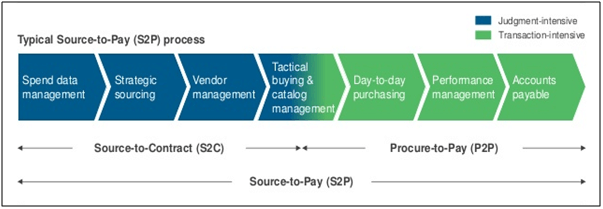Digital technologies are revolutionizing the procurement function and companies increasingly recognize that applying digital to their procurement processes can yield significant competitive advantage yet adoption of new technologies has been slow. That is because the complexity of the technology landscape makes tech selection daunting. Furthermore, some technologies are in use but continually evolving, while others are not mature enough to be widely industrialized.
Organizations that ground their digitization efforts in their overall business and procurement goals are much more likely to be successful. Therefore, the organization needs to have a good understanding of which enablers best support the value that is deemed most important for the procurement strategy. For example, if speed is paramount, the company should place a heavy emphasis on streamlining processes; if innovation is a strong focus, internal and external collaborations are crucial. The deployment of enablers should not begin with technology considerations but with strategic priorities.

Table of Contents
Organization as an Enabler
Digital procurement will fundamentally change roles within the department and, therefore, the organizational setup as well. Robotic process automation (RPA) and artificial intelligence (AI) will take over a large proportion of the repetitive tasks that operational buyers typically perform.
In the near future, digital technologies will have little impact on the activities that are performed by strategic buyers, such as developing category strategies, collaborating with internal business partners, or interacting with suppliers. However, it will affect many other tasks. With structured data lakes and big data analytics, it will eliminate the need for buyers to consolidate data sets and conduct basic analyses. In the long term, such activities will be fully automated.

AI-based technologies will be important because they will help buyers involved in negotiation preparation and supplier selection. Thus, strategic buyers will need to develop AI-related skills. At the same time, digital will create the need for new roles. To enable AI-based decisions, procurement organization will need to set up a central master data and advanced analytics team dedicated to digital analytics. It will also be necessary to create a small group that will program and maintain the robots required for automation tasks. Procurement organizations will need to develop different role descriptions for these employees and provide them with digital training. They will have to identify and attract digital talent, especially data scientist. The function will likely shrink in size, but the greater number of digital experts will create a much higher value.
Processes as an Enabler
The overall procurement process consists of three sets of actions:
• Planning-to-strategy (P2S) covers the foundational strategy work, beginning with the allocation of resources and ending with the definition of the category strategy.
• Source-to-contract (S2C) begins with the defining of individual projects and their needs and ends with the signing of supplier contracts.
• Procure-to-pay (P2P) starts with the decision to buy a good or service and ends with delivery and payment.
The S2C and P2P processes will see major digital changes in the near future. All types of technologies — automation, AI, and cognitive agents — will be important but AI will have the biggest impact on S2C processes. This is because it will help buyers make the best decisions for maximizing savings as well as innovation goals. Automation will play the largest role in the P2P process because automated order-processing solutions for tailored buying channels will save much time and also has the potential to reduce the number of staff needed for transactional tasks by up to 50% and by an even larger percentage in the long term as new robotic solutions are introduced.

People as an Enabler
Employees’ capabilities which are obviously critical for realizing the value of all kinds, can benefit greatly from digital solutions. Buyers, for example, can use online solutions to assess their skills in areas such as analytics, strategic thinking, and negotiation tactics and therefore managers can add their perspective to these assessments.

This is the basis for capability-building plans that buyers can tailor to their role. Although skills like analytics can be taught online, negotiation techniques are taught more effectively in person.
Although digital help people enhance their skills in some ways, it also requires them to adapt their skills to the new technology landscape. Given the declining need for conventional operational roles, buyers will need to learn how to deploy digital technologies to boost various dimensions of value.
Performance Management as an Enabler
The performance management system provides an overview of the main parameters that the procurement department uses to manage and communicate its performance to stakeholders. An effective system also provides information on how much individual employees have contributed to the department’s overall goals.
The full content is only visible to SIPMM members
Already a member? Please Login to continue reading.
References
Karen Osmundsen, Jon Iden. (2018). “Digital Transformation Drivers, Success Factors, and Implications”. Retrieved from: https://www.researchgate.net/publication/330397210_DIGITAL_TRANSFORMATION_DRIVERS_SUCCESS_FACTORS_AND_IMPLICATIONS, accessed on 23/06/2019.
Karin Wang Huijuan, ADPSM (2019). “Blockchain for Visibility in the Food Supply Chain”. Retrieved from SIPMM: https://publication.sipmm.edu.sg/blockchain-visibility-food-supply-chain/, accessed on 24/06/2019.
Martin Högel, et.al. (2018). “Delivering on Digital Procurement’s Promise”
Retrieved from: https://www.bcg.com/publications/2018/delivering-digital-procurement-promise.aspx, accessed on 23/06/2019.
Michelle Lee Ean Wei, ADPSM. (2019). “New Technologies that will Impact Future Supply Chains”. Retrieved from SIPMM: https://publication.sipmm.edu.sg/new-technologies-impact-future-supply-chains/, accessed on 24/06/2019.
Nic Walden. (2017). “Four key areas for digital transformation in procurement”
Retrieved from: https://www.supplychaindigital.com/procurement/four-key-areas-digital-transformation-procurement, accessed on 23/06/2019.
Raimar Hoeliner. (2018). “Critical Success Factors for Each Phase of Digital Transformation”. Retrieved from: https://www.digitalistmag.com/cio-knowledge/2018/11/13/critical-success-factors-for-each-phase-of-digital-transformation-06193854, accessed on 23/06/2019.
Reinhard Geissbauer, et.al. (2016). “Procurement 4.0: Are you ready for the digital revolution?”Retrieved from https://www.strategyand.pwc.com/report/procurement-4-digital-revolution, accessed on 23/06/2019.

